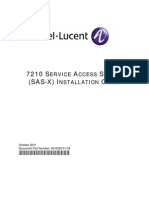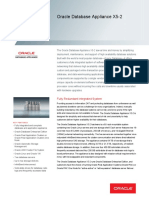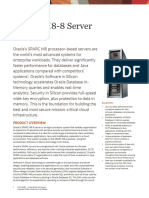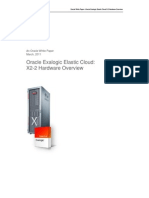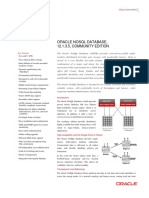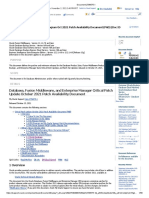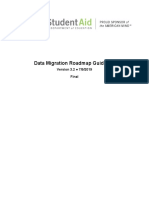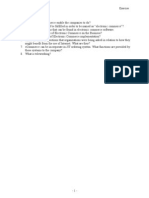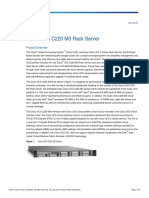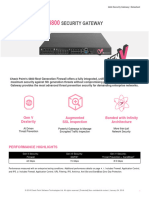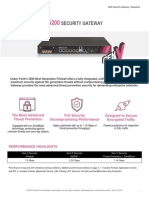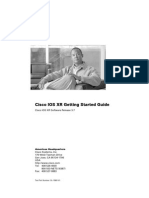Oracle Database Appliance X9-2-HA: Fully Redundant Integrated System
Oracle Database Appliance X9-2-HA: Fully Redundant Integrated System
Uploaded by
Twins LeongCopyright:
Available Formats
Oracle Database Appliance X9-2-HA: Fully Redundant Integrated System
Oracle Database Appliance X9-2-HA: Fully Redundant Integrated System
Uploaded by
Twins LeongOriginal Title
Copyright
Available Formats
Share this document
Did you find this document useful?
Is this content inappropriate?
Copyright:
Available Formats
Oracle Database Appliance X9-2-HA: Fully Redundant Integrated System
Oracle Database Appliance X9-2-HA: Fully Redundant Integrated System
Uploaded by
Twins LeongCopyright:
Available Formats
Data Sheet
Oracle Database Appliance
X9-2-HA
Oracle Database Appliance X9-2-HA is an Oracle Engineered System Oracle Database Appliance
that saves time and money by simplifying deployment, management, X9-2-HA
and support of high availability database solutions. Optimized for the
world’s most popular database— Oracle Database—it integrates
software, compute, storage, and network resources to deliver high Key Features
availability database services for a wide range of custom and Fully integrated and
packaged online transaction processing (OLTP), in-memory database, complete database and
application appliance
and data warehousing applications. All hardware and software
Oracle Database Enterprise
components are engineered and supported by Oracle, offering Edition and Standard Edition
customers a reliable and secure system with built-in automation and Oracle Real Application
best practices. In addition to accelerating the time to value when Clusters or Oracle Real
Application Clusters One
deploying high availability database solutions, Oracle Database Node
Appliance X9-2-HA offers flexible Oracle Database licensing options Oracle ASM and ACFS
and reduces operational expenses associated with maintenance and Oracle Appliance Manager
support.
Browser User Interface (BUI)
Integrated Backup and Data
Guard
Fully Redundant Integrated System Software Development Kit
(SDK) and REST API
Providing access to information 24/7 and protecting databases from unforeseen
Oracle Cloud Integration
and planned downtime can be challenging for many organizations. Indeed,
manually building redundancy into database systems can be risky and error- Oracle Linux and Oracle
Linux KVM
prone if the right skills and resources are not available in-house. Oracle Database
Appliance X9-2-HA is designed for simplicity and reduces that element of risk Hybrid Columnar
Compression often delivers
and uncertainty to help customers deliver higher availability for their databases. 10X-15X compression ratios
The Oracle Database Appliance X9-2-HA hardware is an 8U rack-mountable Two servers with up to two
system containing two Oracle Linux servers and one storage shelf. Each server storage shelves
features two 16-core Intel® Xeon® S4314 processors, 512 GB of memory, and Solid-state drives (SSDs) and
choice of either a dual-port 25-Gigabit Ethernet (GbE) SFP28 or a quad-port hard disk drives (HDDs)
10GBase-T PCIe network adapter for external networking connectivity with the
option to add up to two additional dual-port 25GbE SFP28 or quad-port
10GBase-T PCIe network adapters. The two servers are connected via a 25GbE
interconnect for cluster communication and share direct-attached high-
performance SAS storage. The base system's storage shelf is partially populated
with six 7.68 TB solid-state drives (SSDs) for data storage, totaling 46 TB of raw
storage capacity.
1 ORACLE DATABASE APPLIANCE X9-2-HA
Copyright © 2022, Oracle and/or its affiliates
Oracle Database Appliance X9-2-HA runs Oracle Database Enterprise Edition or Key Benefits
Oracle Database Standard Edition. It offers customers the option of running World’s #1 database
single-instance databases or clustered databases utilizing Oracle Real Simple, optimized, and
Application Clusters (Oracle RAC) or Oracle RAC One Node for "active-active" or affordable
"active-passive" database server failover. Oracle Data Guard is integrated with High availability database
the appliance to simplify standby databases' configuration for disaster recovery. solutions for a wide range of
applications
Optional Storage Expansion Ease of deployment,
patching, management, and
Oracle Database Appliance X9-2-HA offers the flexibility to expand the storage diagnostics
shelf that comes with the base system by adding up to eighteen additional SSDs
Simplified backup and
or hard disk drives (HDDs) for data storage. A fully populated storage shelf disaster recovery
contains either twenty-four SSDs or six SSDs and eighteen HDDs for data Reduced planned and
storage, for a total of 184 TB SSD or 46 TB SSD and 324 TB HDD raw storage unplanned downtime
capacity, respectively. Customers can also optionally add a second storage shelf Cost-effective consolidation
to double the storage capacity of the system. Also, external NFS storage is platform
supported for online backups, data staging, or other database files. Capacity-on-demand
licensing
Ease of Deployment, Management, and Support Rapid provisioning of test
and development
To help customers quickly deploy and manage their databases, Oracle Database
environments with database
Appliance comes with Appliance Manager software to simplify the system's snapshots
administration and diagnosis. The Appliance Manager feature dramatically
Single-vendor support
simplifies the deployment process and ensures that the system and database
configuration adhere to Oracle's best practices. The browser user interface
quickly gathers all the configuration parameters to streamline both system and
database provisioning with a few easy steps. The Appliance Manager also
drastically simplifies maintenance by patching the entire appliance, including all
firmware and software, using an Oracle-tested patch bundle explicitly
engineered for the appliance. Simply select the appropriate patch bundle in the
browser user interface to validate it and update the entire system. Database
backup and recovery are integrated into the Appliance Manager to backup
locally, external storage, or the Oracle Cloud directly through the browser user
interface. The Appliance Manager also tracks system and database information
and displays the information in the browser user interface. Built-in diagnostics
continually monitor the appliance and detect component failures, configuration
issues, and deviations from best practices. In addition, Oracle Database
Appliance Auto Service Request (ASR) feature can automatically log service
requests with Oracle Support to help speed resolution of issues.
Flexible Oracle Database Software Licensing
Oracle Database Appliance X9-2-HA supports both Oracle Database Enterprise
Edition and Standard Edition. Enterprise deployments that require the enhanced
feature set of Oracle Database Enterprise Edition can take advantage of a unique
capacity-on-demand database software licensing model to quickly scale utilized
processor cores without any hardware upgrades. Customers can deploy the
system and license as few as 2 processors cores to run their database servers,
and incrementally scale up to the maximum of 64 processor cores. This enables
customers to deliver the performance and reliability that enterprise business
2 ORACLE DATABASE APPLIANCE X9-2-HA
Copyright © 2022, Oracle and/or its affiliates
users demand, and align software spend with business growth. Small
enterprises, line-of-business departments, and branch office deployments that
don’t require enterprise class features can license Oracle Database Standard
Edition, allowing them to realize the benefits of Oracle Database Appliance to
reduce costs and improve productivity.
Integrated Virtualization Support
Virtualization provides IT cost savings and better resource utilization through
consolidation of multiple physical servers as Virtual Machines in an Oracle
Database Appliance. It helps reduce space, power, and cooling for data centers
and provides isolation for workloads to improve service quality for applications
and databases. Oracle Database Appliance supports two types of Kernel-based
Virtual Machines (KVM) that can be quickly deployed using built-in user
interfaces: Application KVM and Database KVM (a.k.a. database system). In an
application KVM, customers manage the installation and maintenance of the
application, while in the Database KVM, the Oracle Database Appliance manages
the installation and maintenance of the Oracle Database.
KVM database systems enable hard partitioning for Oracle Database licensing,
where each KVM database system can have its own CPU pool that is
automatically assigned during KVM database system creation, or share a CPU
pool. Oracle Database Appliance simplifies the management of KVM database
systems with built-in user interfaces. Oracle Database Appliance X9-2-HA also
offers built-in high availability features, auto-restart, and failover for application
KVMs.
Solution-In-A-Box Through Virtualization
Oracle Database Appliance X9-2-HA enables customers and ISVs to quickly
deploy database and application workloads on a single Oracle Database
Appliance. Support for virtualization adds additional flexibility to the already
complete and fully integrated database solution by providing isolation between
database and application instances.
Customers and ISVs benefit from a complete solution that efficiently utilizes
resources and takes advantage of capacity-on-demand licensing for multiple
workloads by leveraging Oracle KVM hard partitioning.
Conclusion
For customers seeking a simple, optimized, and affordable database solution,
the Oracle Database Appliance X9 model family offers optimized purpose-built
hardware and software choices for every organization. The Oracle Database
Appliance is engineered across every technology stack level, resulting in easier
deployment and upgrades and more efficient management. With the Oracle
Database Appliance X9 model family, customers can quickly bring new services
to the market while improving their service levels – adding business value to
their company.
To learn more about the Oracle Database Appliance X9 model family, visit:
www.oracle.com/oda
3 ORACLE DATABASE APPLIANCE X9-2-HA
Copyright © 2022, Oracle and/or its affiliates
Oracle Database Appliance X9-2-HA Specifications
ARCHITECTURE
System § Two 2U X9-2L servers and one 4U DE3-24C storage shelf per system
§ Optional second storage shelf may be added for storage expansion
Processor § Two Intel® Xeon® processors per server
§ Intel® Xeon® Silver 4314 2.4 GHz, 16 cores, 135 watts, XCC, 24 MB L3 cache
Cache § Level 1: 32 KB instruction and 32 KB data L1 cache per core
§ Level 2: 1 MB shared data and instruction L2 cache per core
§ Level 3: up to 1.375 MB shared inclusive L3 cache per core
Main Memory § 512 GB (16 x 32 GB) per server
§ Optional memory expansion to 1 TB (32 x 32 GB) per server
§ Both servers must contain the same amount of memory
Server Storage § Two internal 240 GB M.2 SSDs (mirrored) per server for Operating System and Oracle Grid Infrastructure
(GI) Software
STORAGE (STORAGE SHELF DE3-24C)
HIGH PERFORMANCE
Data Storage Usable Capacity Usable Capacity
Quantity Raw Capacity
(Double Mirroring) (Triple Mirroring)
Base System 6 x 7.68 TB SSD 46 TB 17.8 TB 11.9 TB
Plus 6 SSDs 12 x 7.68 TB SSD 92 TB 35.6 TB 23.7 TB
Plus 6 SSDs 18 x 7.68 TB SSD 138 TB 53.4 TB 35.6 TB
Full Shelf 24 x 7.68 TB SSD 184 TB 71.2 TB 47.5 TB
Double Shelf 48 x 7.68 TB SSD 368 TB 142.5 TB 95.0 TB
HIGH CAPACITY
Full Shelf 6 x 7.68 TB SSD 46 TB 17.8 TB 11.9 TB
(SSDs Plus HDDs) 18 x 18 TB HDD 324 TB 125.2 TB 83.5 TB
Double Shelf 12 x 7.68 TB SSD 92 TB 35.6 TB 23.7 TB
(SSDs Plus HDDs) 36 x 18 TB HDD 648 TB 250.5 TB 167.0 TB
• Base system storage shelf contains six solid-state drives (SSDs)
• Additional SSDs must be added in groups of six
• Hard-disk drives (HDDs) must be added in groups of eighteen to fully populate the entire storage shelf
• Optional second storage shelf for storage expansion must be fully populated.
• The raw storage capacity is based on storage industry conventions where 1 TB equals 1,0004 bytes.
• The usable storage capacity is based on operating system conventions where 1 TB equals 1,0244 bytes and accounts for 15% reserved space required to
rebuild full redundancy in case of disk failure.
I NTERFACES
Standard I/O • One 100Mb/1Gb ethernet port and one serial RJ45 port per server
• One USB 3.0 ports (one rear) per server
• PCIe slot 1: dual-port 25 GbE (SFP28) card (Interconnect)
• PCIe slot 2: dual-port external SAS HBA
• PCIe slot 4: Choice of quad-port 10GBase-T card or dual-port 10/25 GbE (SFP28) card (Optional)
• PCIe slot 6: Choice of quad-port 10GBase-T card or dual-port 10/25 GbE (SFP28) card
• PCIe slot 8: Choice of quad-port 10GBase-T card or dual-port 10/25 GbE (SFP28) card (Optional)
• PCIe slot 9: dual-port external SAS HBA
• Note: No additional PCIe cards can be added in the non-mentioned slots
4 ORACLE DATABASE APPLIANCE X9-2-HA
Copyright © 2022, Oracle and/or its affiliates
SYSTEMS MANAGEMENT
Interfaces § Dedicated 10/100/1000 M Base-T network management port
§ In-band, out-of-band, and side-band network management access
§ RJ45 serial management port
Service Processor Oracle Integrated Lights Out Manager (Oracle ILOM) provides:
§ Remote keyboard, video, and mouse redirection
§ Full remote management through command-line, IPMI, and browser interfaces
§ Remote media capability (USB, DVD, CD, and ISO image)
§ Advanced power management and monitoring
§ Active Directory, LDAP, and RADIUS support
§ Dual Oracle ILOM flash
§ Direct virtual media redirection
Monitoring § Comprehensive fault detection and notification
§ In-band, out-of-band, and side-band SNMP monitoring v3
§ Syslog and SMTP alerts
§ Automatic creation of a service request for key hardware faults with Oracle auto service request (ASR)
SOFTWARE
Oracle Software § Oracle Linux (Pre-Installed)
§ Oracle Linux KVM (Pre-Installed and optional to use)
§ Appliance Manager (Pre-Installed)
Oracle Database Software § Choice of Oracle Database software, depending on the desired level of availability:
(Licensed Separately) - Oracle Database 21c Enterprise Edition, Standard Edition 2
- Oracle Database 19c Enterprise Edition, Standard Edition 2
- Oracle Database 12c Enterprise Edition Release 1, Release 2, Standard Edition 2
- Oracle Real Application Clusters One Node
- Oracle Real Application Clusters
§ Support for:
- Oracle Database options
- Oracle Enterprise Manager Management Packs for Oracle Database Enterprise Edition
Capacity-On-Demand § Enable and license 2, 4, 6, 8, 10, 12, 16, 20, 24, 28, or 32 cores per server
Software Licensing for Oracle § Note: Both servers must have the same number of cores enabled, however, it is possible to license software
Database Enterprise Edition for only one of the servers or both servers, depending on the high availability requirements
ORACLE DATABASE APPLIANCE SOFTWARE FEATURES
MANAGEABILITY
Appliance Manager The software interface for the Oracle Database Appliance simplifies the deployment, management, and
support of your Oracle Database Appliance.
Management Interfaces Command Line interface (CLI), Web Browser Interface (BUI), and REST/API.
Database Templates Pre-defined (based on Oracle best practices database parameters) database templates sized for best
performance to satisfy various workloads for OLTP, DSS, and In-Memory.
Capacity-on-Demand A database licensing capability to enable only the processor cores (two minimum) required and to easily
Licensing scale to a higher number as business needs change.
Single Patch for Entire Stack Provides a single patch for the entire stack that includes the latest Oracle Database RU, Oracle GI, Oracle
Linux, Hardware firmware updates, etc. Applying Out-of-Cycle Database Patches is also supported.
Integrated KVM Virtualization Linux kernel-based virtual machine (KVM) enables virtualization for Oracle Database or Applications.
Supports Hard Partitioning for Oracle Database licensing.
CPU Pools Enable management of CPU resources, providing QoS (Quality of Service) by guaranteeing dedicated CPU
resources for Databases and VMs. (note: CPU pools cannot be used for Oracle Database licensing)
Automated Serviceability Through Oracle Auto Service Request (ASR), problems are resolved faster with ASR, which automatically
opens service requests for your Oracle Database Appliance when specific faults occur.
5 ORACLE DATABASE APPLIANCE X9-2-HA
Copyright © 2022, Oracle and/or its affiliates
Automated Monitoring The ODA Hardware Monitoring Tool displays the status of different hardware components in Oracle
Database Appliance server. It reports information only for the node on which you run the command.
Automated Diagnostics Oracle Database Appliance uses Oracle Autonomous Health Framework, which collects and analyzes
diagnostic data, and proactively identifies issues before they affect the health of your system.
ODA Software Development The ODA SDK publicly exposes the ODA REST and Java API to invoke ODA database services
Kit (SDK) programmatically.
Oracle Enterprise Manager The ODA EM Plug-In supports detailed monitoring of one or multiple Oracle Database Appliances and
(OEM) Plug-In provides actionable component level analytics across an ODA group
HIGH AVAILABILITY
Automated Deployment RAC Integrated Oracle RAC (Real Application Cluster) configuration to deploy a RAC system in 90 minutes or
less
Integrated Standard Edition Standard Edition High Availability (SEHA) uses Oracle Grid Infrastructure to provide cluster-based failover
High Availability (SEHA) for Oracle Database 19c Standard Edition 2 databases (with ODA HA model only)
DATA PROTECTION
Automated Database Backup Integrated RMAN for simple backup operation of Oracle Databases to Oracle Cloud Infrastructure Object
(including to Cloud) Storage or Internal FRA/ External FRA. Restore can be done to different levels (latest, PITR, SCN, etc.)
Integrated Data Guard Oracle Database Appliance provides client interface through ODACLI commands for easy configuration
Configuration and management of Oracle Data Guard for high availability, data protection, and disaster recovery.
Integrated Database Security Run DBSAT reports directly from the Browser User Interface (BUI). The Oracle Database Security
Assessment Tool (DBSAT) Assessment Tool (DBSAT) helps identify areas where your database configuration, operation, or
implementation introduces risks and recommends changes and controls to mitigate those risks.
System Disk Backup Use Oracle Database Appliance Backup and Recovery (ODABR) to back up the system disks to ensure easy
restore if the patching operation fails. ODABR restores the system disk to pre-patching state.
Other Data Protection • Prioritize Recovery of Critical Database Files
Features • Automatic Repair of Corrupt Disk Data
DATA MANAGEMENT
Built-in Storage Management Integrated ASM for simplified storage management, where the user only selects a few options, and the
Appliance Manager automatically configures ASM
Integrated Database Clones Rapid and efficient database copies using integrated ACFS Snapshots to provision database environments
for development and testing of applications.
Hybrid Columnar Enables the highest levels of data compression possible with Oracle databases, often delivering 10X-15X
Compression (HCC) Support compression ratios. It provides substantial cost-savings and performance improvements due to reduced
I/O, especially for analytic workloads. (Requires ODA SW 18.8 or higher, and Oracle EE license).
SECURITY AND COMPLIANCE
Hardening • Installed packages are trimmed to a minimum, so that unnecessary packages are not installed
• Only essential services are enabled on the Oracle Database Appliance nodes
• Operating system users are audited
• Secure configurations for NTP, SSH, and other services
Security Capabilities • Isolation policies
• Controlled access to data
• Cryptographic services
• Monitoring and auditing
• Unified Auditing for Oracle database
• Oracle Integrated Lights Out Manager (ILOM) for secure management
Encryption Integrated TDE support for database lifecycle management, including backup and iRestore
(Oracle Database Transparent Data Encryption [TDE] requires Advanced Security Option license)
Multi-User Access Create multiple users with different roles that restrict them from accessing resources created by other
users and restrict the set of operations they can perform.
Compliance • FIPS 140-2 Level one compliant
• STIG (Security Technical Guide) security audit script
• Secure erase drives
6 ORACLE DATABASE APPLIANCE X9-2-HA
Copyright © 2022, Oracle and/or its affiliates
Adaptive Classification and Enables the sanitization of sensitive diagnostic data, such as Host names, IP and MAC addresses, Oracle
Redaction (ACR) Database names, tablespace names, user data that may leak into redo and block dumps in trace files, etc.
Some features are specific to Oracle Database Enterprise Edition (Data Guard, TDE, etc.) and need to be licensed appropriately. Others are
included with either the Oracle Database Enterprise Edition (i.e., HCC) or Standard Edition (i.e., SEHA) licensing. Talk to your Oracle Database
sales representative for details.
ENVIRONMENTAL
Environmental Temperature, § Operating temperature: 5°C to 35°C (41°F to 95°F)
Humidity, Altitude § Nonoperating temperature: -40°C to 70°C (-40°F to 158°F)
§ Operating relative humidity: 10% to 90%, noncondensing
§ Nonoperating relative humidity: Up to 93%, noncondensing
§ Operating altitude: Maximum ambient operating temperature is derated by 1°C per 300 m of elevation
beyond 900 m, up to a maximum altitude of 3000 m (except in China where regulations may limit
installations to a maximum altitude of 6,560 feet or 2,000 m)
§ Nonoperating altitude: up to 39,370 feet (12,000 m)
§ 8.1 Bels A-weighted Operating, and 5.8 Bels A-weighted Idling (measured Sound Power).
Check your local regulations for noise level exposure limits in the workplace that apply to your installation
of Oracle equipment and appropriate use of personal protection equipment.
POWER AND THERMAL
Power § Two 1,200 watt hot-swappable and redundant power supplies, rated 96% efficiency
- Rated line voltage: 100 to 240 VAC
- Rated input current 100 to 127 VAC 10 A and 200 to 240 VAC 7 A
§ Two 580 Watt hot-swappable, redundant power supplies per storage shelf, rated 88% efficiency
- Rated line voltage: 100 to 240 VAC
- Rated input current: 100 VAC 8A and 240 VAC 3A
Two Server in HA config § Maximum power usage: 1,120W, 3,822 BTU/Hr
(Max Memory) § Active Idle power usage: 516W, 1,760 BTU/Hr
Storage Shelf § Maximum power usage: 449W, 1,529 BTU/Hr
(DE3-24C: 24 x 7.68 TB SSDs) § Typical power usage: 276W, 940 BTU/Hr
Storage Shelf § Maximum power usage: 434W, 1,479 BTU/Hr
(DE3-24C: 6 x 7.68 TB SSDs, § Typical power usage: 271W, 925 BTU/Hr
18 x 18 TB HDDs)
PHYSICAL SPECIFICATIONS
Dimensions and Weight § Height: 86.9 mm (3.4 in.) per server; 175 mm (6.9 in.) per storage shelf
§ Width: 445.0 mm (17.5 in.) per server; 483 mm (19.0 in.) per storage shelf
§ Depth: 759.4 mm (29.9 in.) per server; 630 mm (24.8 in.) per storage shelf
§ Weight: 28.6 kg (63 lb.) per server; 38 kg (84 lbs) per storage shelf
Included Installation Kits § Tool-less rack mounting slide rail kit
§ Cable management arm
REGULATIONS AND CERTIFICATIONS
CERTIFICATIONS1 § NRTL (North America Safety)
§ CE (European Union)
§ International CB Scheme
§ BIS (India)
§ BSMI (Taiwan)
§ CCC (PRC)
§ EAC (EAEU including Russia)
§ KC (Korea)
§ RCM (Australia)
7 ORACLE DATABASE APPLIANCE X9-2-HA
Copyright © 2022, Oracle and/or its affiliates
§ VCCI (Japan)
§ UKCA (United Kingdom)
1 All standards and certifications referenced are to the latest official version. For additional detail, please contact your sales representative. Other country
regulations/certifications may apply.
For regulatory compliance information, please consult the “Safety and Compliance Guide” available in the product’s documentation library at
https://docs.oracle.com.
Connect with us
Call +1.800.ORACLE1 or visit oracle.com. Outside North America, find your local office at: oracle.com/contact.
blogs.oracle.com facebook.com/oracle twitter.com/oracle
Copyright © 2022, Oracle and/or its affiliates. All rights reserved. This document is Oracle and Java are registered trademarks of Oracle and/or its affiliates. Other names may be
provided for information purposes only, and the contents hereof are subject to change trademarks of their respective owners.
without notice. This document is not warranted to be error-free, nor subject to any other
Intel and Intel Xeon are trademarks or registered trademarks of Intel Corporation. All SPARC
warranties or conditions, whether expressed orally or implied in law, including implied
trademarks are used under license and are trademarks or registered trademarks of SPARC
warranties and conditions of merchantability or fitness for a particular purpose. We
International, Inc. AMD, Opteron, the AMD logo, and the AMD Opteron logo are trademarks or
specifically disclaim any liability with respect to this document, and no contractual
registered trademarks of Advanced Micro Devices. UNIX is a registered trademark of The Open
obligations are formed either directly or indirectly by this document. This document
Group. June, 2022
may not be reproduced or transmitted in any form or by any means, electronic or
mechanical, for any purpose, without our prior written permission.
8 ORACLE DATABASE APPLIANCE X9-2-HA
Copyright © 2022, Oracle and/or its affiliates
You might also like
- SJ-20200929135033-015-ZXA10 C680&C600&C650&C620 (V1.2.1) Optical Access Aggregation Equipment Routine Maintenance - 996110Document44 pagesSJ-20200929135033-015-ZXA10 C680&C600&C650&C620 (V1.2.1) Optical Access Aggregation Equipment Routine Maintenance - 996110paulo gadelhaNo ratings yet
- Exadata Training Full SatyaDocument191 pagesExadata Training Full SatyaGanesh Ganeshan80% (5)
- 7210 SAS-X Installation GuideDocument82 pages7210 SAS-X Installation Guidenelusabie100% (3)
- Oracle Exadata Database MachineDocument86 pagesOracle Exadata Database MachineDwaine SnowNo ratings yet
- Oda x10 Ha DatasheetDocument8 pagesOda x10 Ha DatasheetSinh DangNo ratings yet
- Oracle Database Appliance X8-2-HA: Fully Redundant Integrated SystemDocument6 pagesOracle Database Appliance X8-2-HA: Fully Redundant Integrated SystemOliveira RubensNo ratings yet
- Oracle Database Appliance X8-2S / X8-2MDocument5 pagesOracle Database Appliance X8-2S / X8-2MOliveira RubensNo ratings yet
- Oda x8 2sm Datasheet 5730738Document5 pagesOda x8 2sm Datasheet 5730738cedric agokeng kitioNo ratings yet
- Oracle WP Oda x9-2slDocument9 pagesOracle WP Oda x9-2slRick GamingNo ratings yet
- ODA X9 2SL DatasheetDocument8 pagesODA X9 2SL DatasheetYudy UtamaNo ratings yet
- Oracle Big Data Appliance X4-2Document6 pagesOracle Big Data Appliance X4-2fer_vargasNo ratings yet
- Oracle Virtual Compute Appliance X3-2Document6 pagesOracle Virtual Compute Appliance X3-2Johan LouwersNo ratings yet
- Oracle Server X8-2: Product OverviewDocument6 pagesOracle Server X8-2: Product OverviewDurga Prasad MukhiaNo ratings yet
- Oracle Data Guard - Concepts and AdministrationDocument61 pagesOracle Data Guard - Concepts and Administrationoliveira.aderlanNo ratings yet
- Oracle Server X8-2: Product OverviewDocument5 pagesOracle Server X8-2: Product OverviewSanowar HossainNo ratings yet
- x8 2 Datasheet PDFDocument5 pagesx8 2 Datasheet PDFRoy ValenciaNo ratings yet
- Oracle Database 11g Comparison Chart: Key Feature SummaryDocument5 pagesOracle Database 11g Comparison Chart: Key Feature SummaryittichaiNo ratings yet
- X5 Oracle Database Applianc Oracle Database Appliance e X5 2Document5 pagesX5 Oracle Database Applianc Oracle Database Appliance e X5 2Carlos BritezNo ratings yet
- Oracle Database 11g For Data Warehousing and Business IntelligenceDocument13 pagesOracle Database 11g For Data Warehousing and Business Intelligencebhavesh.chanchadNo ratings yet
- Oracle Exadata Database Machine X2-2: Features and FactsDocument7 pagesOracle Exadata Database Machine X2-2: Features and FactsmanickspNo ratings yet
- Oracle Exadata Database Machine X2-8: Features and FactsDocument6 pagesOracle Exadata Database Machine X2-8: Features and Factshal9002No ratings yet
- ODA Data SheetDocument5 pagesODA Data SheetfahadcaderNo ratings yet
- Oda x10 Model Family Tech BriefDocument11 pagesOda x10 Model Family Tech BriefMWANAHAWA BAKARINo ratings yet
- Oracle Server X6-2: Product OverviewDocument6 pagesOracle Server X6-2: Product OverviewGrace ValenciaNo ratings yet
- Oracle Database 11g For Data Warehousing and Business IntelligenceDocument14 pagesOracle Database 11g For Data Warehousing and Business IntelligenceAdi PopNo ratings yet
- Oracle Database 11g For Data Warehousing and Business IntelligenceDocument13 pagesOracle Database 11g For Data Warehousing and Business Intelligenceleniadz2No ratings yet
- Oracle 11gdb ProductsDocument18 pagesOracle 11gdb Productsjey011No ratings yet
- Oracle Server X6-2L: Product OverviewDocument6 pagesOracle Server X6-2L: Product OverviewDurga Prasad MukhiaNo ratings yet
- M8-8 Datasheet+ (012422) 3Document7 pagesM8-8 Datasheet+ (012422) 3Rick GamingNo ratings yet
- Oracle Exalogic Elastic Cloud: X2-2 Hardware Overview: An Oracle White Paper March, 2011Document17 pagesOracle Exalogic Elastic Cloud: X2-2 Hardware Overview: An Oracle White Paper March, 2011Duc Toan PhamNo ratings yet
- Oracle Zfs Storage Appliance DatasheetDocument11 pagesOracle Zfs Storage Appliance DatasheetHans-Peter PospisilNo ratings yet
- Maa WP GG Oracledbm 128760 PDFDocument24 pagesMaa WP GG Oracledbm 128760 PDFMarlon CostaNo ratings yet
- Secure Backup 12.2 - DatasheetDocument4 pagesSecure Backup 12.2 - DatasheetHot MaleNo ratings yet
- Database 11g Standard Edition DatasheetDocument2 pagesDatabase 11g Standard Edition DatasheetGilberto MonroyNo ratings yet
- Solution Guide: Flex System Solution For Oracle RAC: Bryan Reese Ajay Dholakia Thomas ParkerDocument16 pagesSolution Guide: Flex System Solution For Oracle RAC: Bryan Reese Ajay Dholakia Thomas ParkerVijay ShankarNo ratings yet
- Active Data Guard WP 12c 1896127Document21 pagesActive Data Guard WP 12c 1896127Alberto Hernandez HernandezNo ratings yet
- Oracle ClusterwareDocument2 pagesOracle Clusterwaredavis ouyang100% (1)
- Oracle Database 11 Product Family: An Oracle White Paper June 2012Document19 pagesOracle Database 11 Product Family: An Oracle White Paper June 2012Aliasger BharmalNo ratings yet
- Sparc t8 4 Ds 3864254Document7 pagesSparc t8 4 Ds 3864254Jhony HidayatNo ratings yet
- Oracle Exadata Database Machine X9M-2: Data SheetDocument29 pagesOracle Exadata Database Machine X9M-2: Data SheetMirza Jubayar TopuNo ratings yet
- Exadata Technical Whitepaper PDFDocument29 pagesExadata Technical Whitepaper PDFMatian DalNo ratings yet
- Oracle Server X7-2: Product OverviewDocument6 pagesOracle Server X7-2: Product OverviewAnil RawatNo ratings yet
- Oracle Database EditionsDocument14 pagesOracle Database EditionsnucrocNo ratings yet
- Oracle Exadata Database Machine X7-2: Engineered System For Fast and Reliable DeploymentDocument24 pagesOracle Exadata Database Machine X7-2: Engineered System For Fast and Reliable Deploymentfajar setiawanNo ratings yet
- Oracle Real Application Clusters: Key Features and BenefitsDocument2 pagesOracle Real Application Clusters: Key Features and BenefitsPrasanta PadhiNo ratings yet
- OracleDocument23 pagesOracleari_prasNo ratings yet
- Oracle Nosql Database,: 12.1.3.5, COMMUNITY EDITIONDocument5 pagesOracle Nosql Database,: 12.1.3.5, COMMUNITY EDITIONCarlos Mario HerreraNo ratings yet
- Exadata Technical Whitepaper 134575Document31 pagesExadata Technical Whitepaper 134575Jyothi JohnNo ratings yet
- Sparc t8 2 Ds 3864232 PDFDocument6 pagesSparc t8 2 Ds 3864232 PDFanhtuan29No ratings yet
- Oracle Exadata Database Machine Sl6: All The Benefits of Exadata Combined With Ultra-Fast SPARC Processors Running LinuxDocument22 pagesOracle Exadata Database Machine Sl6: All The Benefits of Exadata Combined With Ultra-Fast SPARC Processors Running LinuxJeffNo ratings yet
- Oracle Exadata Database Machine X4-2: Features and FactsDocument17 pagesOracle Exadata Database Machine X4-2: Features and FactsGanesh JNo ratings yet
- X7-2 Datasheet Oracle Servers PDFDocument6 pagesX7-2 Datasheet Oracle Servers PDFHope HimuyandiNo ratings yet
- Setting Up Oracle 11g Data Guard For SAP CustomersDocument60 pagesSetting Up Oracle 11g Data Guard For SAP CustomersUdit SharmaNo ratings yet
- Dbmachine x2 2 Datasheet PDFDocument9 pagesDbmachine x2 2 Datasheet PDFQuangvinh HPNo ratings yet
- LSI MegaRAID Software User GuideDocument49 pagesLSI MegaRAID Software User GuideAhmed EidNo ratings yet
- Getting Started with CockroachDB: A guide to using a modern, cloud-native, and distributed SQL database for your data-intensive appsFrom EverandGetting Started with CockroachDB: A guide to using a modern, cloud-native, and distributed SQL database for your data-intensive appsNo ratings yet
- Oracle Database 11g - Underground Advice for Database Administrators: Beyond the basicsFrom EverandOracle Database 11g - Underground Advice for Database Administrators: Beyond the basicsNo ratings yet
- The Definitive Guide to Azure Data Engineering: Modern ELT, DevOps, and Analytics on the Azure Cloud PlatformFrom EverandThe Definitive Guide to Azure Data Engineering: Modern ELT, DevOps, and Analytics on the Azure Cloud PlatformNo ratings yet
- Arcgis Pro Migration Guide: Publication Date: June 2021Document12 pagesArcgis Pro Migration Guide: Publication Date: June 2021Twins LeongNo ratings yet
- Gnss Post-Processing Software: Surveying & EngineeringDocument4 pagesGnss Post-Processing Software: Surveying & EngineeringTwins LeongNo ratings yet
- 06 Pivot SoftwareDocument78 pages06 Pivot SoftwareTwins LeongNo ratings yet
- Pillar Axiom 600: Hardware Installation GuideDocument229 pagesPillar Axiom 600: Hardware Installation GuideTwins LeongNo ratings yet
- Worksheet: Classification of Living ThingsDocument1 pageWorksheet: Classification of Living ThingsTwins LeongNo ratings yet
- Database, Fusion Middleware, and Enterprise Manager Critical Patch Update October 2021 Patch Availability DocumentDocument58 pagesDatabase, Fusion Middleware, and Enterprise Manager Critical Patch Update October 2021 Patch Availability DocumentTwins LeongNo ratings yet
- ERDAS-Engine Whitepaper 2015Document9 pagesERDAS-Engine Whitepaper 2015Twins LeongNo ratings yet
- QueryManager 2015 PDFDocument170 pagesQueryManager 2015 PDFTwins LeongNo ratings yet
- Data Migration Roadmap Guidance: Version 3.2 7/9/2019 FinalDocument53 pagesData Migration Roadmap Guidance: Version 3.2 7/9/2019 FinalTwins Leong100% (1)
- Ps Query 201 Intermediate Training ManualDocument97 pagesPs Query 201 Intermediate Training ManualTwins LeongNo ratings yet
- Creating Queries PDFDocument45 pagesCreating Queries PDFTwins LeongNo ratings yet
- 4037 w15 QP 13Document16 pages4037 w15 QP 13Twins LeongNo ratings yet
- The Micrometer: V. Ryan © 2004 - 2009Document3 pagesThe Micrometer: V. Ryan © 2004 - 2009Twins LeongNo ratings yet
- Pop SelectDocument10 pagesPop SelectTwins LeongNo ratings yet
- PIC18F4580Document483 pagesPIC18F4580Twins Leong100% (1)
- EC Ex1Document1 pageEC Ex1Twins LeongNo ratings yet
- Comb GatesDocument5 pagesComb GatesTwins LeongNo ratings yet
- Data - Sheet - c78-700626 UCS Server CiscoDocument6 pagesData - Sheet - c78-700626 UCS Server CiscoVictor Rafael Atencia UruetaNo ratings yet
- 6800 Security Gateway DatasheetDocument5 pages6800 Security Gateway DatasheetalembrhanNo ratings yet
- PowerFlex 4.0 Installation-SSP V2 - Downloadable ContentDocument20 pagesPowerFlex 4.0 Installation-SSP V2 - Downloadable ContentMWANAHAWA BAKARINo ratings yet
- 5200 Security Gateway DatasheetDocument5 pages5200 Security Gateway DatasheetJoseNo ratings yet
- Juniper MX960 Hardware GuideDocument590 pagesJuniper MX960 Hardware Guideiqbal apriansyahNo ratings yet
- Onecli BKDocument246 pagesOnecli BKAK SWCSNo ratings yet
- Hitachi Unified Compute Platform 1000 For Vmware Evo:Rail Installation and Reference ManualDocument95 pagesHitachi Unified Compute Platform 1000 For Vmware Evo:Rail Installation and Reference ManualVương NhânNo ratings yet
- Lnvgy FW Uefi U8e122h-1.50 Anyos 32-64Document4 pagesLnvgy FW Uefi U8e122h-1.50 Anyos 32-64Jonathan SantosNo ratings yet
- Cisco IOS XR Getting Started GuideDocument224 pagesCisco IOS XR Getting Started Guideranjan_meheraNo ratings yet
- Introduction With The WiMAX Equipments AlvarionDocument38 pagesIntroduction With The WiMAX Equipments AlvarionSubir Chandra Mazumdar50% (2)
- Ver6 ManualDocument221 pagesVer6 Manualborle_vilasNo ratings yet
- 6500 Security Gateway DatasheetDocument5 pages6500 Security Gateway Datasheetgarytj21No ratings yet
- Mcafee Email and Web Security Appliance Model 3000 Memory Upgrade GuideDocument12 pagesMcafee Email and Web Security Appliance Model 3000 Memory Upgrade GuideMihell AnhellNo ratings yet
- Hardware Installation and Troubleshooting GuideDocument62 pagesHardware Installation and Troubleshooting GuideAdam Van HarenNo ratings yet
- XR IosDocument312 pagesXR Ioshector_oliveros_9898No ratings yet
- M4300Document59 pagesM4300sudiptakpNo ratings yet
- Python For Serial Communication PDFDocument21 pagesPython For Serial Communication PDFHelder PintoNo ratings yet
- PTP 820 Ethernet Port Segregation Configuration - PTP - Cambium CommunityDocument2 pagesPTP 820 Ethernet Port Segregation Configuration - PTP - Cambium CommunitypepeNo ratings yet
- SKU GTC Manual 42004 784CDocument56 pagesSKU GTC Manual 42004 784CDario Campos AlcantaraNo ratings yet
- ActualTest 642-871Document121 pagesActualTest 642-871Mok JackieNo ratings yet
- 450-3708-011 - Z-Series - DCN - Planning-And - Configuration - 2.0Document45 pages450-3708-011 - Z-Series - DCN - Planning-And - Configuration - 2.0sumabangNo ratings yet
- UAT EC-Pasuruan EX4200Document28 pagesUAT EC-Pasuruan EX4200Ary FajriNo ratings yet
- Paper: IBM System Storage DS3950 IntroductionDocument18 pagesPaper: IBM System Storage DS3950 IntroductionTerence MuripoNo ratings yet
- SNR S2980G 8T Configuration GuideDocument418 pagesSNR S2980G 8T Configuration GuidemikkhailNo ratings yet
- Powerconnect-8100 Setup Guide En-UsDocument368 pagesPowerconnect-8100 Setup Guide En-UsVashan KailasanathanNo ratings yet
- Manual - MXK 319 (0050 0122)Document73 pagesManual - MXK 319 (0050 0122)guillermoNo ratings yet
- OLT 1308S 22 EspecificacionesDocument7 pagesOLT 1308S 22 EspecificacionesRoger Vargas CNo ratings yet
- Client Automation PortifólioDocument8 pagesClient Automation PortifóliobolinavazNo ratings yet


